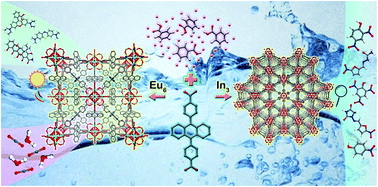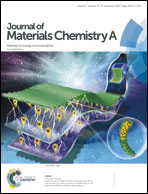Two anthracene-based metal–organic frameworks for highly effective photodegradation and luminescent detection in water†
Abstract
In this work, guided by the molecular building blocks (MBBs) strategy, an anthracene-based linear organic ligand 4,4′-(9,10-anthracenediyl)dibenzoic acid (H2ADBA) is selected to synthesize two MOFs [(CH3)2NH2]2[Eu6(OH)8(ADBA)6(H2O)6]·(DMF)15 (Eu-ADBA) and [In3O(ADBA)3(H2O)3](NO3)·(H2O)6 (In-ADBA) by a solvothermal reaction using a modulator method. Eu-ADBA and In-ADBA which have hexanuclear 12-connected and trinuclear 6-connected MBBs exhibit classic fcu and acs topologies, respectively, and possess high thermostability and water-stability. Eu-ADBA performs broadly visible light absorption and highly photocatalytic activity. Photodegradation of antibiotics (tetracycline) and organic dyes (rhodamine B and methylene blue) in water is performed, and the pore effect is further investigated. In-ADBA exhibits excellent fluorescence detective properties for antibiotics (nitrofurazone and nitrofurantoin) and nitroaromatics (2,4,6-trinitrophenol, 2,4-dinitrophenol and 4-nitrophenol) in water by the quenching effect. This work presents the introduction of the anthracene group into classical topological frameworks and reveals highly effective photocatalytic and detective capabilities.



 Please wait while we load your content...
Please wait while we load your content...